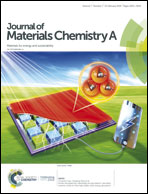New high-energy-density GeTe-based anodes for Li-ion batteries†
Abstract
A layered germanium telluride (GeTe) and its C-modified nanocomposite (GeTe–C) are synthesized by a simple solid-state synthesis technique, and their electrochemical behaviors for rechargeable lithium-ion batteries (LIBs) are evaluated. Various ex situ analytical tools are employed to demonstrate the electrochemical Li-insertion/-extraction mechanisms of the electrodes. GeTe during Li-insertion exhibits two-step conversion/alloying reactions, and does not recombine after Li-extraction. Interestingly, although GeTe–C shows the same two-step conversion/alloying reactions during Li-insertion, Ge and Te fully recombine after Li-extraction. Owing to the full recombination reactions by the ongoing Li-cycling, GeTe–C shows excellent electrochemical Li-ion storage performances, such as highly reversible capacities (1st Li-insertion/-extraction capacity: 841/691 mA h g−1 or 1767/1450 mA h cm−3), extremely rigid cycling durability (capacity retention: 97.8% after 100 cycling), and rapid rate-capabilities (940 mA h cm−3 at 3C-rate). Therefore, the GeTe–C modified with layered GeTe and amorphous C is a promising anode material with a high energy density for high-performance LIBs.



 Please wait while we load your content...
Please wait while we load your content...